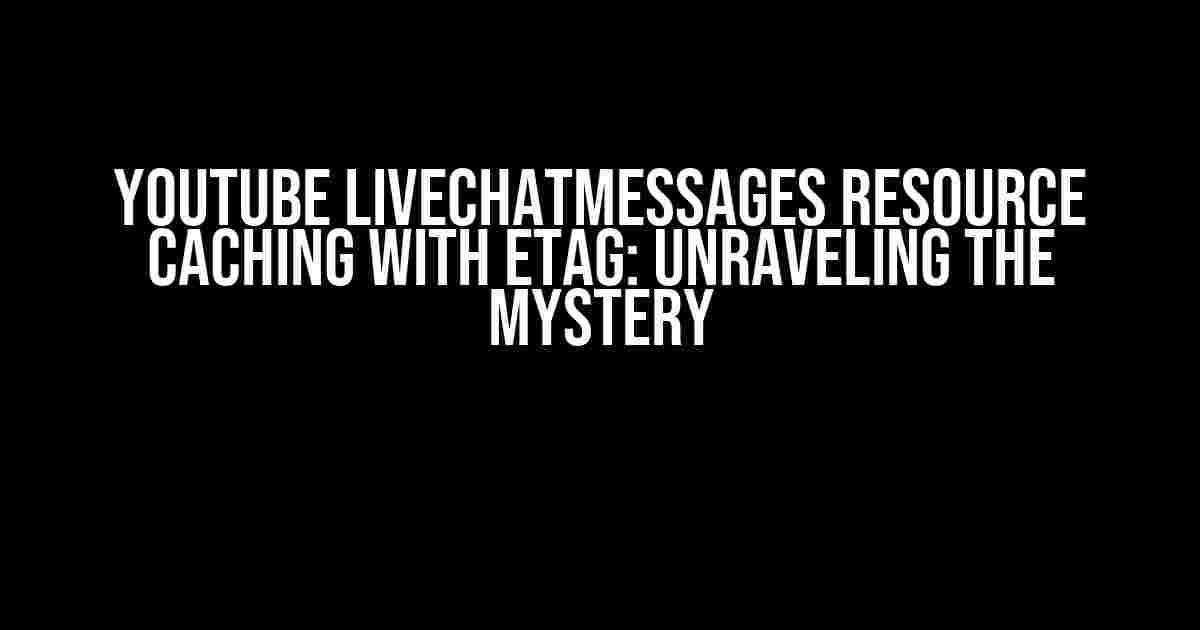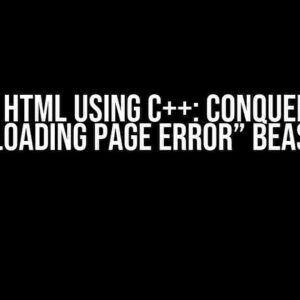Are you tired of dealing with the frustrating issue of Youtube LiveChatMessages resource caching not working with ETag? You’re not alone! This pesky problem has been plaguing developers for far too long, but fear not, dear reader, for we’re about to dive into the solution together. Buckle up, because we’re about to embark on a journey to demystify the world of ETags and caching!
Understanding Caching and ETags
Before we dive into the nitty-gritty, let’s take a step back and briefly discuss what caching and ETags are all about.
Caching: A Quick Primer
Caching is a technique used to improve the performance of web applications by storing frequently accessed resources in a temporary storage area. This allows for faster access to the resources, reducing the number of requests made to the server. In the context of the Youtube API, caching is essential to reduce the load on the API and prevent excessive requests.
ETags: A Deeper Dive
ETags, short for Entity Tags, are a type of caching mechanism that allows for more efficient caching of resources. An ETag is a unique identifier assigned to a resource, which changes whenever the resource is updated. When a client requests a resource, it includes the ETag in the request. If the ETag matches the one on the server, the server returns a 304 Not Modified response, indicating that the client’s cached copy is still valid.
The Problem: Youtube LiveChatMessages Resource Caching with ETag Not Working
Now that we’ve covered the basics, let’s talk about the issue at hand. When using the Youtube API to fetch LiveChatMessages, you might notice that the ETag returned in the response is not being respected by the API. This means that even when you include the ETag in subsequent requests, the API still returns the full response, rather than a 304 Not Modified response.
This can lead to a few issues:
- Excessive requests to the API, leading to rate limiting and potential errors
- Increased latency and slower performance
- Inefficient use of resources, leading to higher costs and decreased scalability
Solving the Problem: A Step-by-Step Guide
So, what’s the solution to this ETag conundrum? Fear not, dear reader, for we’re about to walk through a step-by-step guide to getting ETags working with the Youtube LiveChatMessages resource.
Step 1: Enable Caching on the API Request
The first step is to enable caching on the API request. You can do this by including the following headers in your request:
GET /youtube/v3/liveChat/messages?part=id%2Csnippet&liveChatId=YOUR_LIVE_CHAT_ID HTTP/1.1 Host: www.googleapis.com Cache-Control: max-age=300 If-None-Match: "YOUR ETAG HERE"
In this example, we’re including the `Cache-Control` header with a `max-age` of 300, indicating that the response should be cached for 5 minutes. We’re also including the `If-None-Match` header with the ETag value from the previous response.
Step 2: Parse the ETag Response Header
When you receive the response from the API, you’ll need to parse the ETag response header. This can be done using your preferred programming language. For example, in Node.js, you might use the following code:
const etag = response.headers['etag'];
Make sure to store the ETag value for future requests.
Step 3: Include the ETag in Subsequent Requests
When making subsequent requests to the API, include the ETag value in the `If-None-Match` header:
GET /youtube/v3/liveChat/messages?part=id%2Csnippet&liveChatId=YOUR_LIVE_CHAT_ID HTTP/1.1 Host: www.googleapis.com Cache-Control: max-age=300 If-None-Match: "YOUR ETAG HERE"
This tells the API to return a 304 Not Modified response if the ETag matches the one on the server.
Step 4: Handle the 304 Not Modified Response
When you receive a 304 Not Modified response, you can safely use the cached response from your previous request:
if (response.statusCode === 304) {
// Use the cached response
const cachedResponse = cache.get('liveChatMessages');
// ...
} else {
// Update the cache with the new response
cache.set('liveChatMessages', response.body);
}
Troubleshooting Common Issues
While following these steps should get ETags working with the Youtube LiveChatMessages resource, you might still encounter some issues. Let’s troubleshoot some common problems:
Issue 1: ETag Not Being Returned
If the ETag is not being returned in the response, check the following:
- Make sure you’re including the `Cache-Control` header with a valid `max-age` value.
- Verify that the API is configured to return ETags.
Issue 2: ETag Not Being Respected
If the ETag is being returned, but not respected by the API, check the following:
- Make sure you’re including the `If-None-Match` header with the correct ETag value.
- Verify that the API is configured to respect ETags.
Best Practices for Caching with ETags
Now that we’ve covered the basics of ETags and caching with the Youtube LiveChatMessages resource, let’s discuss some best practices to keep in mind:
- Use a cache layer**: Implement a cache layer to store responses from the API. This can be done using a caching library or a dedicated caching service.
- Set a reasonable cache TTL**: Set a reasonable cache TTL (time to live) to ensure that your cache is updated regularly.
- Use ETags wisely**: Use ETags to validate the cache, but avoid relying solely on them for caching.
- Implement cache invalidation**: Implement cache invalidation to ensure that your cache is updated when the underlying data changes.
Conclusion
And there you have it, folks! With these steps and best practices, you should be well on your way to getting ETags working with the Youtube LiveChatMessages resource. Remember to cache wisely, and don’t hesitate to reach out if you have any further questions or concerns.
| Resource | ETag | Cache TTL |
|---|---|---|
| LiveChatMessages | Supported | 5 minutes (recommended) |
By following these guidelines, you’ll be able to optimize your application’s performance, reduce latency, and improve overall user experience. Happy caching!
Frequently Asked Questions
Are you having trouble with YouTube LiveChatMessages resource caching with ETag? We’ve got you covered! Check out these frequently asked questions to troubleshoot the issue.
Why is my YouTube LiveChatMessages resource caching with ETag not working?
It’s possible that your ETag is not being updated correctly, causing the cache to return stale data. Check your implementation and ensure that the ETag is being updated with each new message. Also, verify that your cache is properly configured to respect the ETag.
How do I troubleshoot ETag issues with YouTube LiveChatMessages resource caching?
Start by checking the HTTP response headers to ensure that the ETag is being returned correctly. You can use tools like Postman or cURL to inspect the headers. Next, verify that your cache is properly configured to respect the ETag and that it’s not returning stale data. If you’re still stuck, try debugging your code to see where the issue lies.
What is the purpose of ETag in YouTube LiveChatMessages resource caching?
The ETag (Entity Tag) is a unique identifier for a specific version of a resource. In the context of YouTube LiveChatMessages resource caching, the ETag helps determine whether the cached data is up-to-date or not. When the ETag changes, it indicates that the resource has been updated, and the cache should be refreshed.
Can I use other caching mechanisms besides ETag with YouTube LiveChatMessages resource?
While ETag is the recommended approach, you can use other caching mechanisms like Last-Modified or Cache-Control headers. However, keep in mind that these alternatives might not be as efficient or effective as ETag. If you’re experiencing issues with ETag, it’s worth exploring these alternatives, but be prepared to handle any potential trade-offs.
What are some common mistakes to avoid when implementing ETag caching for YouTube LiveChatMessages resource?
Don’t forget to update the ETag when the resource changes! Also, make sure to properly handle cache expiration and stale data. Another common mistake is not respecting the ETag when fetching data from the cache. Finally, ensure that your implementation is correctly handling errors and edge cases.




